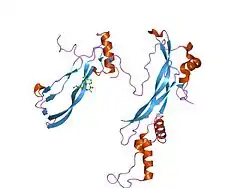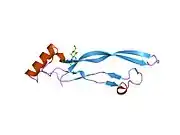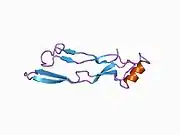Bone morphogenetic protein 7
Bone morphogenetic protein 7 or BMP7 (also known as osteogenic protein-1 or OP-1) is a protein that in humans is encoded by the BMP7 gene.[5]
Function
The protein encoded by this gene is a member of the TGF-β superfamily. Like other members of the bone morphogenetic protein family of proteins, it plays a key role in the transformation of mesenchymal cells into bone and cartilage. It is inhibited by noggin and a similar protein, chordin, which are expressed in the Spemann-Mangold Organizer. BMP7 may be involved in bone homeostasis. It is expressed in the brain, kidneys and bladder.[6]
BMP7 induces the phosphorylation of SMAD1 and SMAD5, which in turn induce transcription of numerous osteogenic genes.[7] It has been demonstrated that BMP7 treatment is sufficient to induce all of the genetic markers of osteoblast differentiation in many cell types.[6]
Role in vertebrate development
The role of BMP7 in mammalian kidney development is through induction of MET of the metanephrogenic blastema.[8] The epithelial tissue emerging from this MET process eventually forms the tubules and glomeruli of the nephron.[8] BMP-7 is also important in homeostasis of the adult kidney by inhibiting ephithelial-mesenchymal transition (EMT). BMP-7 expression is attenuated when the nephron is placed under inflammatory or ischemic stress, leading to EMT, which can result in fibrosis of the kidney.[9] This type of fibrosis often leads to renal failure, and is predictive of end stage renal disease.[10]
BMP7 has been discovered to be crucial in the determination of ventral-dorsal organization in zebrafish. BMP7 causes the expression of ventral phenotypes while its complete inhibition creates a dorsal phenotype. Moreover, BMP7 is eventually partially "turned off" in embryonic development in order to create the dorsal parts of the organism.[11]
In many early developmental experiments using zebrafish, scientists used caBMPR (constitutively active) and tBMP (truncated receptor) to determine the effect of BMP7 in embryogensis. They found that the constitutively active, which causes BMP to be expressed everywhere creates a ventralized phenotype, whereas truncated, dorsalized.
Therapeutic application
Human recombinant BMP7 has surgical uses and was originally marketed under the brand name OP1 (discontinued by Olympus Biotech, who bought it from Stryker). It can be used to aid in the fusion of vertebral bodies to prevent neurologic trauma.[12] Also in the treatment of tibial non-union, frequently in cases where a bone graft has failed.[13] rhBMP-2 is much more widely used clinically because it helps grow bone better than rhBMP-7 and other BMPs.[14]
BMP7 also has the potential for treatment of chronic kidney disease.[15][16] Kidney disease is characterized by derangement of the tubular architecture by both myofibroblast buildup and monocyte infiltration [17] Because endogenous BMP-7 is an inhibitor of the TGF-β signaling cascade that induces fibrosis, the use of exogenous recombinant BMP-7 (rhBMP-7) could be a viable treatment of chronic kidney disease.[8] It is also thought that BMP-7 reverses fibrosis and EMT through reduction in monocyte infiltration into inflamed tissue.[15] On a molecular level, BMP-7 represses inflammation by knocking down the expression of several pro-inflammatory cytokines produced by monocytes.[15] Reducing this inflammatory stress, in turn, reduces the chance of fibrosis.[9]
Regardless of the mechanism of fibrosis or the origin of myofibroblasts, exogenous BMP-7 has been shown to reverse the EMT process and trigger MET.[8] Eventually this restores the healthy epithelial cell population, and normal function of the kidneys in mice.[8] This is pertinent in humans as well, because many diseases stemming from organ fibrosis occur via the EMT process.[9] The epithelial-menenchymal transition is also problematic in cancer metastasis, so the diminution of EMT with recombinant DNA could have great implications in future cancer treatment options.[9]
BMP7 administration has been proposed as a possible treatment for human infertility due to poor response to FSH treatment.[18]
Promotion of brown fat
It was discovered that mice injected with BMP7 increased their production of "good" brown fat cells, while keeping their levels of the normal white fat cells constant. A BMP7 therapy for obesity in humans may be developed as a result.[19][20]
BMP7 not only stimulates brown adipogenesis,[20][21] it also stimulates the "browning" of brite or beige adipocytes, turning them from a white-like phenotype into a brown-like phenotype (with induction of UCP1 and able to perform non-shivering thermogenesis, which allows to disperse energy as heat).[22]
Other possible effects
Several studies suggest that BMP7 may regulate of affect food intake.[23][21]
References
- GRCh38: Ensembl release 89: ENSG00000101144 - Ensembl, May 2017
- GRCm38: Ensembl release 89: ENSMUSG00000008999 - Ensembl, May 2017
- "Human PubMed Reference:". National Center for Biotechnology Information, U.S. National Library of Medicine.
- "Mouse PubMed Reference:". National Center for Biotechnology Information, U.S. National Library of Medicine.
- Hahn GV, Cohen RB, Wozney JM, Levitz CL, Shore EM, Zasloff MA, Kaplan FS (November 1992). "A bone morphogenetic protein subfamily: chromosomal localization of human genes for BMP5, BMP6, and BMP7". Genomics. 14 (3): 759–62. doi:10.1016/S0888-7543(05)80181-8. PMID 1427904.
- Chen D, Zhao M, Mundy GR (December 2004). "Bone morphogenetic proteins". Growth Factors. 22 (4): 233–41. doi:10.1080/08977190412331279890. PMID 15621726. S2CID 22932278.
- Itoh F, Asao H, Sugamura K, Heldin CH, ten Dijke P, Itoh S (August 2001). "Promoting bone morphogenetic protein signaling through negative regulation of inhibitory Smads". The EMBO Journal. 20 (15): 4132–42. doi:10.1093/emboj/20.15.4132. PMC 149146. PMID 11483516.
- Zeisberg M, Bottiglio C, Kumar N, Maeshima Y, Strutz F, Müller GA, Kalluri R (December 2003). "Bone morphogenic protein-7 inhibits progression of chronic renal fibrosis associated with two genetic mouse models". American Journal of Physiology. Renal Physiology. 285 (6): F1060–7. doi:10.1152/ajprenal.00191.2002. PMID 12915382.
- Kalluri R, Weinberg RA (June 2009). "The basics of epithelial-mesenchymal transition". The Journal of Clinical Investigation. 119 (6): 1420–8. doi:10.1172/JCI39104. PMC 2689101. PMID 19487818.
- Wang SN, Lapage J, Hirschberg R (November 2001). "Loss of tubular bone morphogenetic protein-7 in diabetic nephropathy". Journal of the American Society of Nephrology. 12 (11): 2392–9. PMID 11675415.
- Myers DC, Sepich DS, Solnica-Krezel L (March 2002). "Bmp activity gradient regulates convergent extension during zebrafish gastrulation". Developmental Biology. 243 (1): 81–98. doi:10.1006/dbio.2001.0523. PMID 11846479.
- Vaccaro AR, Whang PG, Patel T, Phillips FM, Anderson DG, Albert TJ, Hilibrand AS, Brower RS, Kurd MF, Appannagari A, Patel M, Fischgrund JS (2008). "The safety and efficacy of OP-1 (rhBMP-7) as a replacement for iliac crest autograft for posterolateral lumbar arthrodesis: minimum 4-year follow-up of a pilot study". The Spine Journal. 8 (3): 457–65. doi:10.1016/j.spinee.2007.03.012. PMID 17588821.
- Zimmermann G, Müller U, Löffler C, Wentzensen A, Moghaddam A (November 2007). "[Therapeutic outcome in tibial pseudarthrosis: bone morphogenetic protein 7 (BMP-7) versus autologous bone grafting for tibial fractures]". Der Unfallchirurg (in German). 110 (11): 931–8. doi:10.1007/s00113-007-1347-y. PMID 17989951.
- Even J, Eskander M, Kang J (September 2012). "Bone morphogenetic protein in spine surgery: current and future uses". The Journal of the American Academy of Orthopaedic Surgeons. 20 (9): 547–52. doi:10.5435/JAAOS-20-09-547. PMID 22941797.
- Gould SE, Day M, Jones SS, Dorai H (January 2002). "BMP-7 regulates chemokine, cytokine, and hemodynamic gene expression in proximal tubule cells". Kidney International. 61 (1): 51–60. doi:10.1046/j.1523-1755.2002.00103.x. PMID 11786084.
- González EA, Lund RJ, Martin KJ, McCartney JE, Tondravi MM, Sampath TK, Hruska KA (April 2002). "Treatment of a murine model of high-turnover renal osteodystrophy by exogenous BMP-7". Kidney International. 61 (4): 1322–31. doi:10.1046/j.1523-1755.2002.00258.x. PMID 11918739.
- Morrissey J, Hruska K, Guo G, Wang S, Chen Q, Klahr S (January 2002). "Bone morphogenetic protein-7 improves renal fibrosis and accelerates the return of renal function". Journal of the American Society of Nephrology. 13 Suppl 1: S14–21. PMID 11792757.
- Shi J, Yoshino O, Osuga Y, Nishii O, Yano T, Taketani Y (March 2010). "Bone morphogenetic protein 7 (BMP-7) increases the expression of follicle-stimulating hormone (FSH) receptor in human granulosa cells". Fertility and Sterility. 93 (4): 1273–9. doi:10.1016/j.fertnstert.2008.11.014. PMID 19108831.
- Jha A (2008-08-21). "Obesity: Scientists identify protein that promotes fat-burning". Science. guardian.co.uk. Retrieved 2008-09-03.
- Tseng YH, Kokkotou E, Schulz TJ, Huang TL, Winnay JN, Taniguchi CM, et al. (August 2008). "New role of bone morphogenetic protein 7 in brown adipogenesis and energy expenditure". Nature. 454 (7207): 1000–4. doi:10.1038/nature07221. PMC 2745972. PMID 18719589.
- Townsend KL, Suzuki R, Huang TL, Jing E, Schulz TJ, Lee K, Taniguchi CM, Espinoza DO, McDougall LE, Zhang H, He TC, Kokkotou E, Tseng YH (May 2012). "Bone morphogenetic protein 7 (BMP7) reverses obesity and regulates appetite through a central mTOR pathway". FASEB Journal. 26 (5): 2187–96. doi:10.1096/fj.11-199067. PMC 3336788. PMID 22331196.
- Okla M, Ha JH, Temel RE, Chung S (February 2015). "BMP7 drives human adipogenic stem cells into metabolically active beige adipocytes". Lipids. 50 (2): 111–20. doi:10.1007/s11745-014-3981-9. PMC 4306630. PMID 25534037.
- Boon MR, van den Berg SA, Wang Y, van den Bossche J, Karkampouna S, Bauwens M, De Saint-Hubert M, van der Horst G, Vukicevic S, de Winther MP, Havekes LM, Jukema JW, Tamsma JT, van der Pluijm G, van Dijk KW, Rensen PC (2013-09-16). "BMP7 activates brown adipose tissue and reduces diet-induced obesity only at subthermoneutrality". PLOS ONE. 8 (9): e74083. doi:10.1371/journal.pone.0074083. PMC 3774620. PMID 24066098.
Further reading
- Xiao HQ, Shi W, Zhang Y, Liang YZ (April 2009). "[Effect of bone morphogenic protein 7 on nephrin expression and distribution in diabetic rat kidneys]". Nan Fang Yi Ke da Xue Xue Bao = Journal of Southern Medical University. 29 (4): 671–5. PMID 19403392.
- Murray LA, Hackett TL, Warner SM, Shaheen F, Argentieri RL, Dudas P, Farrell FX, Knight DA (2008). Eickelberg O (ed.). "BMP-7 does not protect against bleomycin-induced lung or skin fibrosis". PLOS ONE. 3 (12): e4039. doi:10.1371/journal.pone.0004039. PMC 2603595. PMID 19112509.
- Freedman BI, Bowden DW, Ziegler JT, Langefeld CD, Lehtinen AB, Rudock ME, Lenchik L, Hruska KA, Register TC, Carr JJ (October 2009). "Bone morphogenetic protein 7 (BMP7) gene polymorphisms are associated with inverse relationships between vascular calcification and BMD: the Diabetes Heart Study". Journal of Bone and Mineral Research. 24 (10): 1719–27. doi:10.1359/jbmr.090501. PMC 2743282. PMID 19453255.
- Garriock HA, Kraft JB, Shyn SI, Peters EJ, Yokoyama JS, Jenkins GD, Reinalda MS, Slager SL, McGrath PJ, Hamilton SP (January 2010). "A genomewide association study of citalopram response in major depressive disorder". Biological Psychiatry. 67 (2): 133–8. doi:10.1016/j.biopsych.2009.08.029. PMC 2794921. PMID 19846067.
- Reddi AH (July 2000). "Bone morphogenetic proteins and skeletal development: the kidney-bone connection". Pediatric Nephrology. 14 (7): 598–601. doi:10.1007/s004670000364. PMID 10912525. S2CID 20757453.
- Gautschi OP, Cadosch D, Zellweger R, Joesbury KA, Filgueira L (2009). "Apoptosis induction and reduced proliferation in human osteoblasts by rhBMP-2, -4 and -7". Journal of Musculoskeletal & Neuronal Interactions. 9 (1): 53–60. PMID 19240369.
- Alarmo EL, Pärssinen J, Ketolainen JM, Savinainen K, Karhu R, Kallioniemi A (March 2009). "BMP7 influences proliferation, migration, and invasion of breast cancer cells". Cancer Letters. 275 (1): 35–43. doi:10.1016/j.canlet.2008.09.028. PMID 18980801.
- Elshaier AM, Hakimiyan AA, Rappoport L, Rueger DC, Chubinskaya S (January 2009). "Effect of interleukin-1beta on osteogenic protein 1-induced signaling in adult human articular chondrocytes". Arthritis and Rheumatism. 60 (1): 143–54. doi:10.1002/art.24151. PMC 2626196. PMID 19116903.
- Yerges LM, Klei L, Cauley JA, Roeder K, Kammerer CM, Moffett SP, Ensrud KE, Nestlerode CS, Marshall LM, Hoffman AR, Lewis C, Lang TF, Barrett-Connor E, Ferrell RE, Orwoll ES, Zmuda JM (December 2009). "High-density association study of 383 candidate genes for volumetric BMD at the femoral neck and lumbar spine among older men". Journal of Bone and Mineral Research. 24 (12): 2039–49. doi:10.1359/jbmr.090524. PMC 2791518. PMID 19453261.
- Dudas PL, Argentieri RL, Farrell FX (May 2009). "BMP-7 fails to attenuate TGF-beta1-induced epithelial-to-mesenchymal transition in human proximal tubule epithelial cells". Nephrology, Dialysis, Transplantation. 24 (5): 1406–16. doi:10.1093/ndt/gfn662. PMID 19056781.
- Honsawek S, Chayanupatkul M, Tanavalee A, Sakdinakiattikoon M, Deepaisarnsakul B, Yuktanandana P, Ngarmukos S (August 2009). "Relationship of plasma and synovial fluid BMP-7 with disease severity in knee osteoarthritis patients: a pilot study". International Orthopaedics. 33 (4): 1171–5. doi:10.1007/s00264-009-0751-z. PMC 2898966. PMID 19301001.
- Sengle G, Ono RN, Lyons KM, Bächinger HP, Sakai LY (September 2008). "A new model for growth factor activation: type II receptors compete with the prodomain for BMP-7". Journal of Molecular Biology. 381 (4): 1025–39. doi:10.1016/j.jmb.2008.06.074. PMC 2705212. PMID 18621057.
- Mitu G, Hirschberg R (May 2008). "Bone morphogenetic protein-7 (BMP7) in chronic kidney disease". Frontiers in Bioscience. 13 (13): 4726–39. doi:10.2741/3035. PMID 18508541.
- Brown A, Stock G, Patel AA, Okafor C, Vaccaro A (2006). "Osteogenic protein-1 : a review of its utility in spinal applications". BioDrugs. 20 (4): 243–51. doi:10.2165/00063030-200620040-00005. PMID 16831023. S2CID 23434940.
- Fajardo M, Liu CJ, Egol K (December 2009). "Levels of expression for BMP-7 and several BMP antagonists may play an integral role in a fracture nonunion: a pilot study". Clinical Orthopaedics and Related Research. 467 (12): 3071–8. doi:10.1007/s11999-009-0981-9. PMC 2772945. PMID 19597895.
- Giannoudis PV, Kanakaris NK, Dimitriou R, Gill I, Kolimarala V, Montgomery RJ (December 2009). "The synergistic effect of autograft and BMP-7 in the treatment of atrophic nonunions". Clinical Orthopaedics and Related Research. 467 (12): 3239–48. doi:10.1007/s11999-009-0846-2. PMC 2772926. PMID 19396502.
- Kalluri R, Neilson EG (December 2003). "Epithelial-mesenchymal transition and its implications for fibrosis". The Journal of Clinical Investigation. 112 (12): 1776–84. doi:10.1172/JCI20530. PMC 297008. PMID 14679171.
- Zhu L, Chuanchang D, Wei L, Yilin C, Jiasheng D (March 2010). "Enhanced healing of goat femur-defect using BMP7 gene-modified BMSCs and load-bearing tissue-engineered bone". Journal of Orthopaedic Research. 28 (3): 412–8. doi:10.1002/jor.20973. PMID 19725097. S2CID 12548359.
- Vieira AR, McHenry TG, Daack-Hirsch S, Murray JC, Marazita ML (September 2008). "Candidate gene/loci studies in cleft lip/palate and dental anomalies finds novel susceptibility genes for clefts". Genetics in Medicine. 10 (9): 668–74. doi:10.1097/GIM.0b013e3181833793. PMC 2734954. PMID 18978678.
- Kron K, Pethe V, Briollais L, Sadikovic B, Ozcelik H, Sunderji A, Venkateswaran V, Pinthus J, Fleshner N, van der Kwast T, Bapat B (2009). "Discovery of novel hypermethylated genes in prostate cancer using genomic CpG island microarrays". PLOS ONE. 4 (3): e4830. doi:10.1371/journal.pone.0004830. PMC 2653233. PMID 19283074.
External links
- bone morphogenetic protein 7 at the US National Library of Medicine Medical Subject Headings (MeSH)
- BMP7 as Molecule of the Year 2011
- Human BMP7 genome location and BMP7 gene details page in the UCSC Genome Browser.







